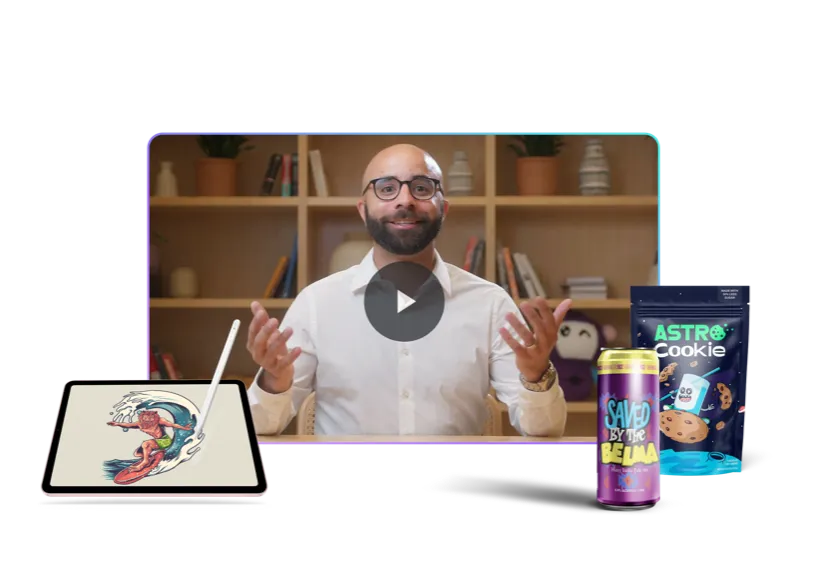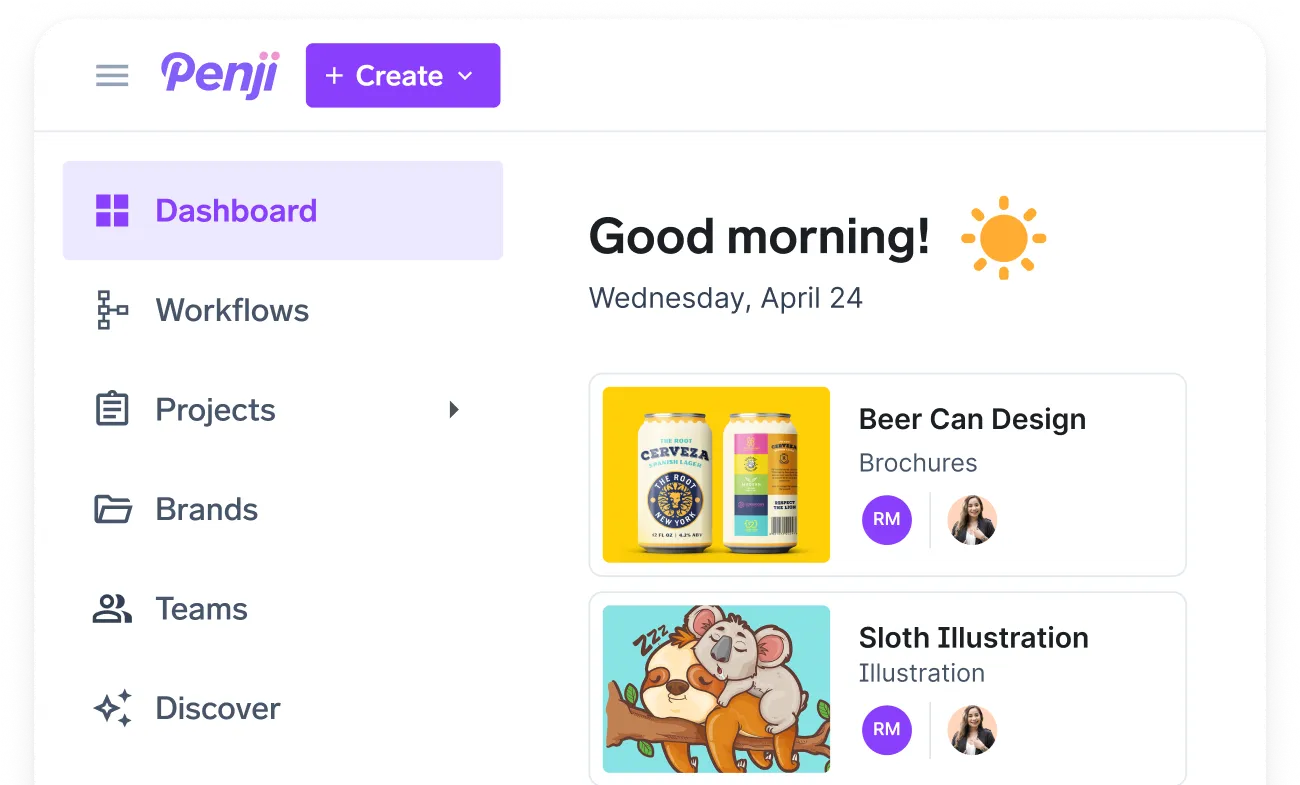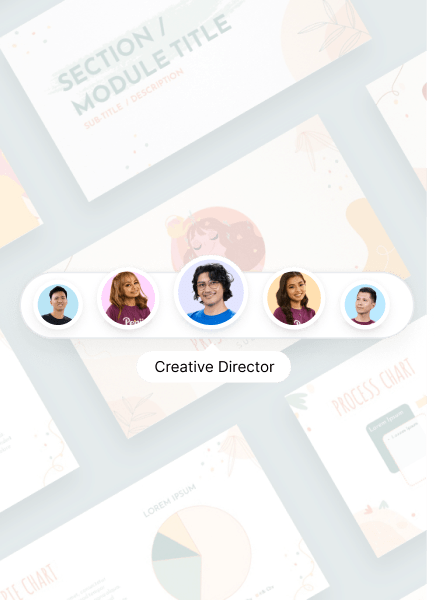![[Fully Managed] Alynn Beyder from PEER39 Ep. 197](https://penji.co/wp-content/uploads/2025/08/BLOG-IMAGE-Alynn-Beyder-1.jpg)
Shannon: Hello, everyone, and thank you for joining us on the Fully Managed Podcast. Thank you so much for joining me. I really appreciate it.
Alynn: Hi. Good to be here.
Game: Market Me This
Shannon: Okay, we are going to start the podcast today by playing a little game. This is one of my favorite games of the podcast. So I hope that you enjoy it. If you don’t, it’s okay. So this game is called Market Me This. So I’m going to give you a somewhat absurd product, and you are going to develop a marketing plan. Obviously, there’s a lot that goes into marketing. So of course, you can’t develop a fully fledged plan right now. But anything that you’d like to delve into specifically that you think would be more enjoyable to talk about the product, whatever it may be. You can go whatever way you want with it. You don’t have to go through like every possible step that you’d go through, but yeah. So you’re excited.
Alynn: I’m so excited. I’m amped.
Shannon: Beautiful. Okay. This product is a scented alarm clock. So this means that instead of waking you up with noise, it wakes you up with a smell. You can choose the smell. I’ve determined all of these things about the made-up product. And that’s all the context you get. Now market this.
Marketing Strategy for Scented Alarm Clock
Alynn: Okay, well, instantly I think about hotels and partnership opportunities, all the ways you could go, but I think I would initially start with the name and coming up with something catchy. I would also definitely include influencers and try to send it around so that there’s real videos of people waking up to this new alarm clock and replacing that jarring noise that you used to wake up to and even like the hatch alarm clock. So focusing more on smell and all the other sensations that you can activate through smell. So there’s partnership opportunities with I don’t even know, like an ENT, an ear nose and throat doctor.
Shannon: That’s really smart, actually.
Alynn: Yeah. Talk to me about the importance of waking up more naturally and not waking up in a state of stress. So focusing more on the wellness aspect of that alarm clock. I don’t know. I would buy it. I just would want to come up with a great name and pricing strategy and push it out to market more organically because it seems like one of those things that you have to actually try and be able to experience yourself.
Shannon: Yeah, no, I think that’s a great plan and I do like the wellness aspect of it because I do think that alarm clocks are not maybe the healthiest thing for people. They are extremely jarring. I think I still have PTSD from waking up in high school to this day of the loudest blaring alarm clock that I’ve ever had.
Alynn: Yeah, I agree. But yeah, I think that’s awesome.
Good Smell vs Bad Smell Discussion
Shannon: I was wondering what… Okay, this is maybe not marketing related, but would you want a good smell or would you want a bad smell?
Alynn: A smell. Or it would be cool if you could program which type of smell you’d like so you have three options or something like that. I love the smell of fresh coffee. I am fully going to wake up to that. Or the smell of something warm to me is always going to be nice. Or laundry. I love the smell of laundry. Something that’s going to make me want to get out of bed versus a nasty smell is going to maybe make me it’ll wake me up, but I don’t think I’ll be waking up in a good mood. So I’m going with, what about you?
Shannon: I don’t know. I was thinking about it because I was like, yes, it’d be lovely to wake up to a good smell, but am I going to wake up to a good smell? Like if I smell a bad smell, I feel like my fight or flight will come in, but then it’s not health related, then it’s still jarring as much as maybe the sound would be. Yeah, I smell a good smell. It’ll just take me longer to get out of bed, but I’ll get out of bed willingly, I think.
Alynn: Yeah, it’s like motivation.
Shannon: Yeah. That’s my phone. Well, thank you for marketing me this. I think you did great. And I think that that was, honestly, I’ve given people way worse products. It’s a product I would use, honestly.
Alynn: I would also use it.
Shannon: There’s other things that I have mentioned that I would use, but are kind of absurd. I think I gave someone like magnet socks at some point that you can’t lose your socks. Anyway, maybe I should have challenged you more. No, I’m just kidding. This was a very good, that was a good introduction to your marketing abilities.
The Possible Conference Experience
Shannon: So speaking of, we talked about before this, oh, I love your nails, by the way. We talked about before this that you recently went to Possible, which is a marketing conference. I would love to know what was something that you learned about your field or maybe even outside of it that you were either surprised about or you thought was very new and exciting to you?
Conference Overview
Alynn: Yeah. So some background on the conference is that it’s only the third year that they’ve been putting this on. It’s in Miami and it’s a massive conference that apparently has doubled in size almost every year. So this year there were close to six thousand attendees. So it was massive with a lot of different panels and masterclasses and workshops that you could attend throughout several days. It kicked off Sunday night and went until Wednesday night with various programming throughout.
Honestly, we were also a sponsor. So my company was one of the sponsors. And so we had an expo space during two of the days. And so it was a lot of working in the booth. It was a lot of being on and speaking to marketers there, speaking to other tech vendors, meeting other companies that I’d never even heard of before.
Key Learnings and AI Focus
Alynn: As far as what I learned from the sessions I was able to attend, there was a huge focus on AI, not surprisingly, different perspectives on the benefits of AI and then some of the cons of generative AI and how we can use the AI to our advantage as marketers. The conference spans industry. So I work currently in ad tech, advertising technology, but there were also tons of MarTech companies there, tons of brand marketers, influencers as well, massive brands. And it was interesting to learn from different perspectives.
Martha Stewart Keynote
Alynn: Some really cool big names like Martha Stewart spoke on stage about how she herself is a brand, which was a cool experience to hear from her, especially talking about her career and how it’s sort of evolved with the times and how she’s had to adjust to social media and how she’s been writing books and all the cool work that she’s been doing and all the philanthropy that she’s been doing. So it was interesting to hear from different agencies who were interviewing her and different ways that she’s tapped into social media herself and marketing herself.
Shannon: Oh, that’s incredible. I love seeing someone that is not in a typical marketing role give marketing advice because I do think that the marketing space is very influenced by so many different places. And I don’t think that necessarily like I think that a lot of people not to take credit away from genius marketers, but I think that a lot of people can get into marketing and do really well with it that maybe don’t have a traditional background. And so it’s really cool.
Marketing at the Conference
Alynn: Yeah, I also want to call out that as a sponsor and the first time attending, I did try to walk around from all the different executions, different cabanas, different experiential experiences that brands were putting on in different booths in the expo space and get ideas of what people were promoting, how they were capturing leads, different giveaways that were happening, different swag that was being given out, different pitches and ways to entice people to come over to your space. I thought that was always interesting too from a marketing perspective to see the different things that’ll bring the consumer in or maybe have a potential prospect come and engage with you willingly, whether they know who you are or aren’t. So it was pretty cool.
Shannon: That’s genius. I didn’t even think about the idea that marketing is so everywhere that I guess I didn’t even think about the stands themselves are a form of marketing because they have to attract your attention. And even worse, the people that are on guard the most about a marketing stunt are marketers. That’s a lot to learn from and take in.
Miami Culture Integration
Alynn: Yeah, it was tons of content, very overstimulating, but in the best way, I think, as Miami is just known to be overstimulating. So always something to do, always a session happening. Or if you wanted to cool off and you went to a bar that was a branded drink for you, some branded napkins available, somebody there to give you a spiel, staff that was wearing t-shirts from a company that was sponsoring the bar, giveaways. They also partnered with local artists in Miami, which I thought was cool. So yeah, it’s an aspect of like that art and community that was really interesting and cool to see as someone who, you know, I traveled to the event. I don’t live, I’m not a local in Miami, so it was interesting to see the different influences, the Miami culture, the music, the art. It was a very energizing conference, I would say.
Shannon: Wow. I really love that too because I think that there’s so many marketers, specifically agencies that work locally, and I think that community is a big part of marketing especially. There’s so many people that have failed marketing campaigns because they don’t consider their local population or they think that something will work when it doesn’t because they don’t consider like the area that they live in and why it wouldn’t work or why it would. And I think that, so having that element in a marketing conference, I think is really cool to like consider the community around you.
Guest: Yeah, I agree.
Learning Outside of Marketing
Shannon: So speaking of, you know, we talked about Martha Stewart, who isn’t like a typical marketer, but is someone that’s clearly very good at it. Has there been a moment in your life where you think that you’ve learned something outside of the marketing space that you think very much helped you in your marketing space, if that makes sense?
Sales and Hospitality Background
Alynn: Yeah, I mean, yes and no. I started off originally in sales. I think everyone has a very different path to get to where they are professionally. I started off in sales years ago, and even throughout college, I had to work in sales to pay for tuition and get through school. And I think a lot of it I didn’t necessarily look at as marketing either, like promoting. When I was working in hospitality specifically, I was like a server, a bartender and then eventually a bar manager and we had events so we had events to bring in new patrons or have like customer loyalty help promote new products that we were.
It was a martini bar and a dessert bar, so we got to promote different ingredients, different drink specials, all those things. And it was pretty cool to be able to be involved in those types of events and then work with our staff to promote Martini Mondays and have like a partnership opportunity with the local manicure salon that came in and did nails and martinis every Monday and get to work on that. But I didn’t look at that at the time. I was still in college. I was still in school. I didn’t really look at it as an opportunity to learn more about marketing or how important marketing is. It was just more of a job that paid my bills that I needed.
Customer Listening Skills
Alynn: But I think I learned a lot more about communicating with people and kind of listening to what your loyal customers want and giving them a voice and a platform. And that’s really helped moving over to the corporate side of things and being able to identify different personas and build your messaging around the different personas. So in the restaurant, we had some repeat customers they were more than willing to share their feedback because they liked the product, so they kept coming back. But it’s more that it’s the product that brings people in. So you want to hear from them what is going to bring their friends in, what don’t they like about it, because can they be critical with you and provide some helpful feedback, whether it’s the prices or if we’re going to increase the price of a drink maybe then we include premium products in that drink. Or maybe we do buy one, get one promotions every once in a while because we know that cost is going to be a detractor for them. So I think listening to the customer has been really important. I guess I just didn’t look at it that way when I was younger.
Shannon: No, that makes complete sense. I think that the service industry really does prepare someone for a marketing or a sales role in such a critical way because it does teach you to listen to the client or the customer because you have to cater to them in that role because you’re directly in contact with them. Whereas I think that where some marketers or even someone that doesn’t have a traditional marketing role but wears many hats, so to speak, miss out in marketing is that they’re not listening to their consumer enough or they create a product that they’re so proud of that they’re not willing to take feedback. And I think that that’s at a detriment to a lot of people. And I think that the service industry prepares you for understanding who you’re working with, like knowing that people have a lot of opinions. And I think it also helps, you know, that you can’t please everyone as well. Like you can try your best to please the people that are loyal and like that, you know, are your target group. But I think it’s a learning curve as well to understand that there’s some people that are just critical as well.
Alynn: Of course.
Product Feedback and Communication
Alynn: I think just communication, focusing on communication was always really important. And even when it came to the product itself, even though the product might have been, so in this case, right, a martini, let’s say a dessert martini might have been what drew someone in. People love a specific type of chocolate martini in this case, and it drew the customers in. But every once in a while, you’re going to get someone who’s not a fan. You can see that they’re not finishing the drink. They might not volunteer any information or explain what they don’t like about it. But I think that that helped as well, be able to probe them and understand a little bit more about what is it that they don’t like? What were they expecting? In that case, was it maybe falsely advertised? They thought it was a chocolate martini that was white chocolate instead of dark chocolate. Things like that that maybe could then inform how we name it on the menu or what ingredients we list or even pricing so I think it’s just being able to engage with customers and getting that feedback and being able then to funnel it to either management or the kitchen or maybe even you know look at the ingredients that we were using and see what changes we could make to the product itself if we notice trends over time.
Shannon: Yeah, no and that’s like it’s such a parallel that you don’t see in marketing of being able to see that, like, the levels in which a customer can help, like, inform your decision on how to advertise, because it is, especially for things like that, that you mentioned, like, maybe they didn’t understand the product entirely. And that’s why they didn’t like it. Like, that is so critical in conveying your story or your product or service clearly so that a consumer understands it because they might complain when they realize it’s not what they thought they were, or they might not even purchase it or want to get involved in it at all because they didn’t fully understand it in the first place. And that’s something that’s really, really important in marketing is being clear with your customers about what you’re actually selling.
Alynn: Yeah. And if they have an issue with the product and then you take the time to engage with them and understand exactly what it is, then they’ll probably hopefully come back. They might not try that exact same product or they’ll at least know what to expect. They’ll come back because they typically will appreciate being listened to if their feedback is taken into account, especially. I think everyone just wants a voice and it was a good learning experience back in the day.
Shannon: Yeah, especially if something is changed or adjusted because of their feedback. I think people really appreciate that because they obviously feel very listened to and cared for. And I think that’s all really the consumer wants because there’s so much noise. Obviously, marketing is everywhere. We’re always like that is everything. And especially with everything with social media and ads and everything, I think that people feel like they’re constantly being advertised to and they don’t want to feel that way so when they feel cared about it doesn’t feel as inauthentic as just an advertisement.
Alynn: Yeah you want it to be relevant to what you actually care about and you want to be in the right mindset when you are being actually you know advertised to or marketed to.
Shannon: No exactly I think that that’s really really important.
AI Integration in Ad Tech
Shannon: So we had talked about a little bit earlier, we touched on AI. And this is like a conversation that I really like having. So there’s, there’s so much. It’s just, it’s so new. So there’s so many different things that I get to learn about from different people about it, because it’s just so fast, and everyone knows different things about it. So for you specifically, with the increasing integration of AI and ad tech, how do you balance automation with also the need of human insight which we kind of just talked about?
AI in Daily Marketing Work
Alynn: Yeah, it’s an everyday learning experience right now for marketing daily I love to use AI for certain things that we need it just saves a lot of time and As far as the customer experience, at my company specifically, we have a platform that customers can use or our account management team uses to build recommendations for clients. So a brand or an agency will reach out and they’ll ask for a suggestion of basically a segment, a targetable segment. They’ll explain what their brand’s KPIs are, what campaign goals they have, and then our account management team will help build a recommendation.
So we’re incorporating our engineering team has incorporated AI into our recommendation tools so that if you just have a few key phrases or a few key terms that the brand maybe wants to target or brands or terms they want to avoid, then our recommendation tool uses AI to help very quickly spit out recommendations and give them a lot more that would normally take a human a very long time to find organically. And then it’s up to the human element to actually sort through and they know their customer, they know the brand, they maybe know their previous campaign experiences, their previous goals. So they might not suggest everything that our AI would spit out. They would tailor it a little bit more knowing the background on the account, knowing other campaigns that they might have running and making sure that everything is tailored to their needs.
Shannon: That’s what I’ve noticed that’s really cool I like that that’s something that you integrated because it still involves the choice of the client to be able to like go through what the options are and determine what is best for them but it’s also Because it’s a tool, there’s probably so many different things that they didn’t think about on that list that are new to them and exciting to be able to work with.
AI as an Expansion Tool
Alynn: Yeah, I think AI can help sort of open up your eyes or like expand that menu, because now I’m thinking of food all of a sudden and restaurant, but it helps sort of open up and give you more options for ingredients. But then it’s sort of up to you what you want that final output to be, what, how long you want it to take to build, like how detailed you want it to be. And then just knowing that, oh, I didn’t think about you know, this recommendation, but now I know it’s in my back pocket. I’m still not going to go the way I was recommended, but I know that that’s an option and I would maybe not have organically thought of that or would have taken me a lot longer on my own to come up with that recommendation and maybe I’ll apply it next time.
Shannon: Yeah, it’s really helpful for finding options because I think that there’s, you know, there’s so It’s such a learning curve to have to come up with so many different solutions for something. I mean, it’s not impossible, but it is something that just is time consuming. And I think that that is like an extremely helpful tool in just making things a little quicker as well.
Customization for Different Brands
Alynn: Yeah, and every brand, especially when you’re dealing with these large Fortune five hundred brands, every brand has its own unique preferences as well and very unique brand guidelines and content that they maybe need to avoid or a specific type of user that they want to reach in a specific environment. So because everyone’s so unique, there’s really like you can lean on AI a lot to just like speed up the process, but it still, I think, requires that human element to know the customer and then also maybe know how to communicate even that recommendation back to them. Some people, depending on who you’re talking to, especially depending on the role at the, in this case, agency, they might want to just see an Excel spreadsheet or like a very long detailed CSV doc that they can filter through with recommendations, with data, but then there’s other personalities, other people on that same account who maybe just want a short email bullet points of what recommendations they need, or they just trust their account management manager entirely to implement those recommendations without ever even having to sit through the data.
Shannon: Yeah, exactly. There’s definitely very different types of clients that want things delivered in a different way because it’s either way too time consuming for them to go through something like that, or they just want things very concise and they just want it like kind of decided for them in a way. So I think that that’s also a great way to kind of like sift through it but also provide a lot of options for the alternative person that wants as much as possible to work with.
Alynn: Yeah I I think so.
Choosing AI Tools
Shannon: So how did you decide what AI tools that you wanted to do or how to integrate AI into your work because I think that with it expanding I think that people kind of walk this line of like incorporating it too much where there’s not that human element or maybe they’re over relying on it in a way that they’re not adapting enough to know how to use all the tools in like the best way. Or yeah, I think there’s just like a lot of problems with it. So how did you decide what was best for you and how to incorporate it rather than like overloading yourself with all of these different tools that are coming out?
Identifying Gaps
Alynn: Yeah, there’s so many tools and so many updates that are constantly happening. Even when you, I think you master, you feel like you may be mastered and you know, an open source generative AI model, and then there’s a new update or a new integration and suddenly you have to learn everything. So for me, it’s just been figuring out where the gaps exist. So for my day job, wherever there’s gaps existing, I work at a small company and we’re a very lean marketing team. So we don’t have all the roles filled. We don’t have a staff designer. And we’ve been using AI a lot for the design elements, for paid ads, for graphics on the website, for our LinkedIn, any type of email comms that we need. And that’s been super helpful. So identifying the gaps of where AI can help where we literally don’t have the skill set on the team and we do need to lean on a tool to help. That’s been great. And then figuring out too how it can, how those tools can then integrate into our project management software just so we can keep track of everything that we’re working on.
Messaging and Positioning
Alynn: Similarly, there’s ways to work with AI that I found really helpful is all the when it comes to messaging and positioning, all the collateral that we have, all the documents that we have, using AI to summarize everything, or maybe read back what you wrote, and then you read it with a different lens. You’re like, does that really make sense? I’m not sure it does. Now that a machine sort of read it back to me, maybe there’s room for improvement in the messaging. Or it might open up your eyes to a different type of messaging that you can use. So after you work on a document or a one-sheeter or even updates to a web page, pushing that through AI, having it spit back out to you or explaining that same message to different types of personas that you have to then tailor your messaging to has been really helpful.
Shannon: Yeah, no, I definitely use it. Summarizing is something that’s extremely helpful, especially for I use it for transcripts for the podcast to come up with main points and I just adjust them based off of, you know, grammatically. It’s not always perfect, but that is so helpful. I used to write them myself before I discovered that I can even use this tool and it was brutal. And yeah, I think that that’s something that’s really great.
Language and Communication
Shannon: And also language, it’s really helpful because I think that I’ve talked to a lot of people where their agency is like worldwide, like it’s global and they can’t, there’s a lot of like disparities between not even like languages in general, but the way in which people speak one language. So say like someone from like a different country may sound more crass to someone who’s like in the Americas. Like I, and I think that I’ve heard from a lot of people that they’ll literally put through their email and AI and say, like, make this sound professional or make this sound nice. And that’s really great, too, because I think that your miscommunication is something that’s so easy in a more like digital space, especially more remote space. And a lot of agencies are. So I think it’s great to have that fix.
Alynn: Yeah, it helps with tone a ton.
Shannon: Yeah, it’s definitely really helpful too for someone that maybe isn’t akin to, you know, like changing their tone or it’s just very difficult for them to figure that out or like the correct language for things. So I think that that’s something that is really great for just making connection’s a little easier because sometimes it is really hard to explain something to someone, especially if it’s bad news, like something that is hard to tell someone. I think that sometimes AI is a little helpful in just being able to change your language so that it’s not something that’s so hard to hear.
Email Tools and Communication Improvements
Alynn: Yeah, and all the integrations in email tools as well, like Grammarly and other tools that will help you with the basics of language as well has been really helpful. And that way you don’t have to think twice about, oh, did I include a comma there? Was that supposed to be an ellipsis? Is that spelled correctly? It just takes some of that guesswork out of the way as well. And to your point about communication, sometimes too, right, you might think that you’ve explained something clearly and then the response you get back, if this is an email or a message you ask, it’s like maybe it wasn’t received the way you intended or maybe there was a better way to communicate it. So I think you being able to use AI in those instances so that AI can see the conversation as opposed to just your intended message and see how it was received can help you avoid further miscommunications or help you refine how you deliver a message in the future if it is bad news to your point or if it’s uncomfortable or if you’re talking about raising prices or if you have some delays that came up with the new product that’s launching or anything that you’re working on.
Shannon: Yeah it’s definitely it’s really helpful because so many people speak in so many different ways like some people ramble or some people I ramble that’s me but there’s people that there’s people that are incredible at their jobs that are just so poor at writing and that is it’s it’s really nice to have a tool like this that is helpful to those people because I think that it’s really it’s really upsetting to be seen as like unintelligent just because you can’t write a good email but you can be like incredible at what you do and it does like show more professionalism to be able to write something clearly to someone and I think that using a tool like that to be helpful is really really great to just like you know, spiffy up a little bit.
Different Communication Styles
Alynn: Yeah. And it’s also good communication, I think, is subjective as well, because I’ve worked with plenty of C-level executives who really just want a very short, concise email or message as opposed to a very well-written email summary but then you work with somebody else who maybe does require that level of detail so that’s again where AI can kind of come in and send the same exact message in different ways to different people who either process information differently or also just communicate differently we’re all we’re all learning off of each other I think and AI has been very helpful but there’s still so much to learn and I think it’s been great in filling the gaps that we have on our team you know, at work, but personally, I use it, I think, daily for communication, especially when I’m feeling a little brain dead after the day and just need to offload something, AI has come in handy.
Shannon: Yeah, it’s incredible for different personalities. Like, I didn’t even think about that, about if you have to deliver the same information in multiple ways, it would just be so time consuming to have to actually just rewrite all of them. So just to be able to, like, enter one and be like, can you write it for this type of person, this type, that’s… It just gives you so much more time in your day to do the things that actually matter rather than sending out that email.
Maintaining Energy Throughout the Day
Alynn: Yeah. And I also think it helps with, I feel like I have a battery. I don’t know if you feel the same where I feel very much like a machine, right? Where you start the day, you might feel fully charged and throughout the day it starts to, you know, you start to downplay, they start to slur your words, get a little slump comes in. So I think AI has been helpful and I think it will continue to be helpful if we use it appropriately to help maintain your battery a little bit longer. And you like rely on these machines and these tools to help, to help make sure that you yourself are not feeling as burnt out or maybe being able to take on more creative work because AI is doing more of the tactical work for you and taking those things off of your plate so you can have more time to think and strategize and implement ideas and then AI actually does it.
Shannon: Yeah, it’s wonderful to have the tedious things done that like take too much of your time and are kind of not something that is enjoyable for people. And it’s nice to be able to pick and choose what you get to use it for.
Alynn: Yeah, yeah. It’s a wonderful thing.
Shannon: I was very hesitant about using it at first because I’m one of those people that it takes me a second for change. And it’s definitely so unbelievably helpful in so many things that took way too much time out of my day that were kind of unnecessary to be doing that.
Alynn: Yeah, agreed.
Keeping Marketing Teams Innovative
Shannon: So for my last question, you talked about your team and how, you know, maybe you don’t have a role devoted to every position that would be ideal, I guess. How do you keep your marketing team innovative and also adaptable when there’s a lot like always changing specifically in the tech industry?
Resource Sharing and Learning
Alynn: Yeah, it can be challenging because, again, you don’t have a ton of resources to work with, but especially with AI and especially with the fact that, you know, we work in tech, we have access to a lot of different resources like on the internet, a lot of different resources. I think anytime I see a newsletter that I like from maybe another vendor or a partner, any newsletters that I see are passing along to the team, or we try to recreate ideas. We get inspired from other concepts from much larger companies maybe that are using tools we don’t have. How can we use our CRM? How can we use our design tools to create something, recreate something that we found to be clean and simple or has different types of links that we really liked?
Similarly, I also do my best to stay on top of podcasts and the trades and try to attend industry events and hear what people are talking about what sort of reports are coming out, following eMarketer, Forrester, Gartner, other analysts and seeing what the trends are, what the expectations are for the second half of the year in our industry. Any, again, tools we should watch out for, any companies we should watch out for, and just sharing that with the team has been helpful. I’ve always appreciated that from management as well. And again, just being able to learn from the tools and mistakes that we, you know, the mistakes we make or the tools that we use and sharing those findings. Knowledge sharing across the company has been really helpful too, whenever that’s possible.
Shannon: Yeah, no, I definitely agree. I think that being able to share anything that you learn is really crucial when you’re working with a team. I think that there’s, there might be something that you think is obvious or that like is very big on the internet that maybe like someone else didn’t realize and something that could really be helpful to your entire team as a whole and it’s really great to be able to have that environment where you feel comfortable and happy to share all these different things.
Alynn: Yeah it’s been good.
Conference Learning and Alternatives
Shannon: Yeah and there’s and then going to conferences like possible I think that that’s something that can really like shape your mind to open it to a whole new world of different marketing tools and different ways in which people are doing I think that it’s also difficult for people to be in their space all the time and learn anything new other than you know just going through maybe linkedin or different different websites that will be helpful for that but I think that being able to actually go out into the world and learn from other marketers or be able to talk to people like this like the podcast and everything like I think it’s really incredible to be able to learn from just like someone else in your role.
Alynn: Yeah, and if you’re not able to attend, there’s a ton of conferences. If you’re not able to attend all those, most companies and most of these events, companies will provide recaps and they will send out newsletters or have blogs or information that’s readily available for you if you’re not able to attend. Or they’ll, again, summarize things on a podcast, promote it on LinkedIn, on X, or any other social media as well.
Depending on the company, like in ad tech, we really pretty much just use LinkedIn. We don’t use X anymore, but there’s not a whole like we don’t really lean into Instagram or TikTok or any of the other social media platforms currently. But I have found that to be very helpful as well to learn more about even very quick tutorials on how to use a new tool or find out too a little bit more sometimes about what the competition is doing, what other companies are doing, get inspired that way and then share those nuggets with my team, see what skills I can learn on my own as well. And it’s great to be able to have tools like Coursera or General Assembly, Udemy, any of those learning platforms as well to just take classes on your own, get certified in different credentials along the way, and then pass that on to the team and encourage everyone to learn outside of work as well. Because I feel inundated with information and opportunity. It’s just about narrowing down what’s most important and what’s going to help, what’s the immediate need for me today.
Shannon: Yeah, no, I think that is perfectly sound advice to end on because we are a little over time, but I do, I, I, one hundred percent agree with you. I think that there is, there’s a lot to learn.
Alynn: Like there’s always so much constantly changing in the marketing space and the tech space and to be able to, you know, filter that out in your own way of what you think is helpful for you specifically and your team specifically. I think that it’s great to be able to pass on that information.
Shannon: Yeah. Agreed. Well, thank you so much for joining me today. I really appreciate it. I learned a lot and I thought this was really fun. Thank you. I had fun. Now I’m hungry after our conversation. The restaurant talking about a martini. I know. And I smell a fresh coffee now. It’s a little, or it’s late here for coffee.
Alynn: No, it’s late for coffee. I would stay up all night if I had coffee now. Shannon: But yes, I’ve enjoyed our conversation. But thank you again so much. And maybe you’ll come up with a set of alarm clock in the future and patent that. um I looked it up and there’s something like it but not really but thank you again so much for joining me thank you everyone for watching or listening really appreciate you guys and I hope you get to learn from another episode as well um and check it out thank you so much and have a lovely day.














